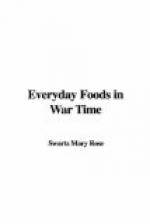A wholesome and yet economical diet may be built upon a plan wherein we find for an average working man fourteen ounces of cereal food and one pint of milk, from two to four ounces of meat or a good meat substitute, two ounces of fat, three ounces of sugar or other sweeteners, at least one kind of fruit, and one kind of vegetable besides potatoes (more if one has a garden).
The cereal may furnish half the fuel value of the diet, partly bread-stuffs and partly in some of the other ways as suggested, without any danger of undernutrition. Remember the fable of the farmer who told his sons he had left them a fortune and bade them dig on his farm for it after his death, and how they found wealth not as buried treasure but through thorough tillage of the soil. So one might leave a message to woman to look in the cereal pot, for there is a key to health and wealth, and a weapon to win the greatest war the world has ever seen.
CHAPTER III
THE MEAT WE OUGHT TO SAVE
“Do not buy a pound of meat until you have bought three quarts of milk” is a “war sign” pointing two ways. On the one hand it tells us that we need to save meat; on the other, that we should encourage the production of that most indispensable food—milk.
But what a revolution in some households if this advice is heeded! Statisticians tell us that Americans have been consuming meat at the rate of 171 pounds per capita per year, which means nearly half a pound apiece every day for each man, woman, child, and infant in arms. Now, as mere infants and some older folk have not had any, it follows that many of us have had a great deal more. Did we need it? Shall we be worse off without it? Meat is undeniably popular. In spite of the rising price and the patriotic spirit of conservation, meat consumption goes on in many quarters at much the usual rate. There is probably no other one food so generally liked. It has a decided and agreeable flavor, a satisfactory “chew,” and leaves an after-sense of being well fed that many take as the sign of whether they are well nourished or not. It digests well, even when eaten rapidly, and perhaps partly for this reason is favored by the hurried man of affairs. It is easy to prepare and hence is appreciated by the cook, who knows that even with unskillful treatment it will be acceptable and require few accessories to make an agreeable meal. Its rich flavor helps to relieve the flatness of foods like rice, hominy, beans, or bread. From this point of view there is no such thing as a “meat substitute.”
But, nutritionally speaking, meat is only one of many; undeniably a good source of protein, but no better than milk or eggs. A lamb chop is a very nice item on a bill of fare, but the protein it contains can be secured just as well from one large egg, or two level tablespoonfuls of peanut butter, or one and one-fourth ounces of cheese; or a part of the time from a quarter of a cup of dried navy beans or a little less of dried split peas.




